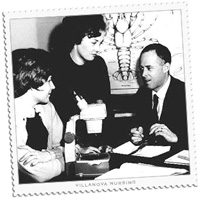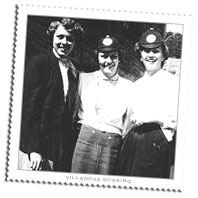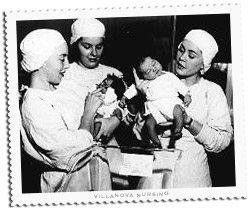History and Tradition
The M. Louise College of Nursing has grown and developed in many ways since its founding. It holds the distinction of being the first collegiate nursing program under Catholic auspices in Pennsylvania, the largest nursing program in the Commonwealth within a private institution, and the only Catholic nursing school in a university under the auspices of the Order of St. Augustine. To date, over 6,000 individuals have graduated from the Fitzpatrick College of Nursing's BSN, MSN and PhD programs. The College is recognized for its leadership and excellence and has been the recipient of numerous Federal grants which have assisted in the development of its programs. The full-time faculty (the majority of whom hold doctoral degrees), reflect a high level of education and involvement in scholarly and professional affairs. In addition to its academic quality, the College is well known for the service and leadership provided by its faculty and alumni, nationally and internationally. The Fitzpatrick College of Nursing continues to be distinguished by its attention to the education of the whole person and the priority it places on a liberal education, human values and ethical concerns, especially as they relate to health and clinical decision making. The Fitzpatrick College of Nursing is an example of an academic unit that clearly reflects centrality to Villanova University's mission.

Early Offerings for Nurses at Villanova
In the 1930s, University administration responded to a need expressed by local Catholic hospital administrators for a program that would give registered nurses an opportunity for additional education at the college level. The program that was developed offered a BSN in Nursing Education and was administered through an extension arrangement under the College of Liberal Arts and Sciences. It had no nurse administrator, nor did it provide a legitimate nursing major at the upper division. Rather, college credit was awarded for nursing courses which students had taken in hospital-based schools; courses in arts and sciences were then taken at Villanova, culminating in a bachelors degree. At the time, this was considered adequate preparation for clinical instructors in hospital schools of nursing.

Reorganization of Nursing into the College of Arts and Sciences
In the Fall of 1950, the University administration reviewed the program and decided to reorganize it to make it eligible for accreditation. After identifying a number of local hospitals and community-based facilities that could be utilized for appropriate clinical laboratory experiences, an academic unit called the division of Nursing was established within the College of Arts and Sciences.

Baccalaureate Program Begins Preparing for Accreditation
Two nurse administrators, Sr. M. Alma Lawler, RSM and Sr. M. Margarella O'Neill, OSF, were appointed co-directors of the Division and charged with reorganizing the Baccalaureate program for registered nurses, to prepare for accreditation, and to align nursing education at Villanova with the needs of a changing field. The faculty appointees at this time were part-time.
During the same period, the growing national trend to educate nurses in colleges and universities influenced academic planning at Villanova. It was believed that nurses should be educated in the liberal arts and sciences and that in addition to providing a sound theoretical foundation for nursing courses, psychosocial, ethical and spiritual dimensions of patient care would be enhanced by such a curriculum. It was also believed that all students who studied for a baccalaureate should have exposure to core content in the humanities. Cognizant of the trends in nursing education, the Catholic hospitals in the Greater Philadelphia area encouraged Rev. Francis X. N. McGuire, OSA, Villanova's President, and Rev. Edward J. McCarthy, OSA, the Academic Dean, to establish a generic baccalaureate program in nursing at Villanova.
